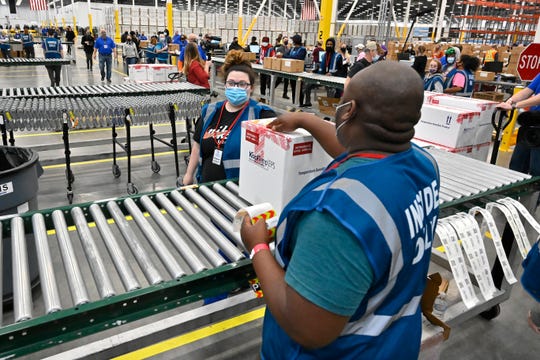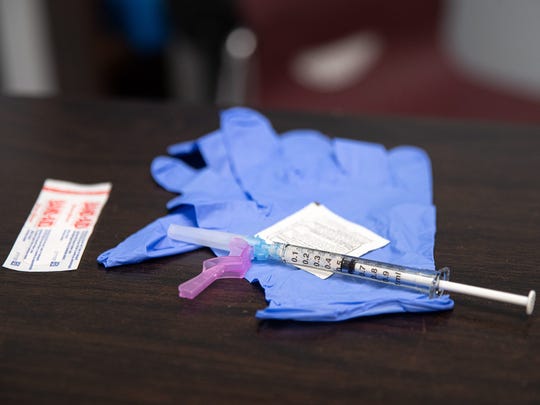Three vaccines. Increased manufacturing. How US will have enough COVID-19 vaccine for every US adult in May – or even sooner.
As vaccine experts welcomed President Joe Biden’s accelerated timeline for distribution, they offered some caution about whether the companies can reach their promised doses and delivery dates. While there’s never 100% certainty in manufacturing, pharmaceutical manufacturing is especially finicky and demanding.
People like to think making vaccines is like making widgets or automobiles but it’s not, said Robert Van Exan, president of Immunization Policy and Knowledge Translation, a vaccine production consulting firm.
The process is complex, with so many variables that vaccine manufacturers can’t count on every batch making it through to the end.
“You can be going along and getting a certain yield and then all of the sudden your yield drops and you don’t know why,” Van Exan said. “Test delays or failures, raw material supply chain, lot failures and yield problems are just some of the examples of things that can result in supply disruptions.”
Biden said Tuesday there will be enough COVID-19 vaccine available in May for every adult in the U.S., nearly two months earlier than his administration predicted three weeks ago, thanks to a deal brokered between pharmaceutical giants Merck and Johnson & Johnson.
That timeline didn’t surprise experts. In fact, some say the U.S. could reach that milestone by mid-April.
‘Vaccine angels’ can only do so much: US struggles to make it easier to find COVID-19 vaccination appointments
To get there, officials plan on 400 million doses from Moderna and Pfizer-BioNTech, enough to vaccinate 200 million people, plus an additional 100 million doses of the one-shot Johnson & Johnson vaccine. That is more than enough for the nation’s 255 million adults.
The achievement “is incredibly exciting and gives me a lot of hope,” said Melissa McPheeters, a professor of health policy and biomedical informatics at Vanderbilt University Medical Center.
“We are within view of turning a corner from a scarcity mindset,” she said.
The administration made use of the Defense Production Act to forge the collaboration between Merck and Johnson & Johnson, usually fierce rivals. It also agreed to invest an additional $100 million to increase manufacturing of the vaccine itself and the vial-filling plants (called “fill and finish”), two of the biggest bottlenecks facing the J&J vaccine, White House coronavirus adviser Andy Slavitt said Wednesday.
The first box containing the Johnson & Johnson COVID-19 vaccine heads down the conveyor to an awaiting transport truck at the McKesson facility in Shepherdsville, Ky., Monday, March 1, 2021. (Photo: Pool photo by Timothy D. Easley)
With the manufacturing boost provided by Merck, Johnson & Johnson has agreed to ship 20 million doses by the end of March and an additional 80 million by the end of May.
Moderna and Pfizer-BioNTech initially planned to deliver their 200 million doses each by the end of June, but manufacturing the vaccines, based on mRNA technology, turned out to be faster than anticipated, speeding the process up by a month, said Moncef Slaoui, head of the vaccine development effort during the Trump administration, told USA TODAY.
The accelerated pace of all three authorized vaccine developments could mean doses will be abundantly available within a month, some experts say.
“I would guess that by mid- to late-April, all adults who want vaccine will be able to get it,” said Dr. Trudy Larson, dean of the school of community health sciences at the University of Nevada-Reno. “At that point, I would think a big push would start for getting all college-going students vaccinated.”
‘Somewhere in there, the vaccine got overpromised’: How the COVID-19 vaccination process turned chaotic and confusing
The Biden administration has promised to have “enough vaccines for every adult by the end of May.” There’s some wiggle room in there.
Officials did not say every adult would be fully vaccinated by then, which would mean two doses for the Pfizer-BioNTech and Moderna shots. They also didn’t say that shots would be in arms but that vaccine would be available.
Still, having enough doses to give at least one to every adult is an impressive accomplishment, said Dr. George Rutherford, an epidemiologist and biostatistician at the University of California, San Francisco.
“It’s wonderful, it’s a huge milestone,” he said.
A COVID-19 vaccine kit includes an alcohol swab, fresh latex gloves, a vaccine syringe, and a bandage. The vaccine kit sits ready for the next patient at the Emergence Health Network DayHab center in East El Paso on Jan. 7, 2021. (Photo: Aaron E. Martinez/El Paso Times)
Now, the next phase – convincing those who aren’t clamoring to get vaccinated – must begin in earnest.
“There are still challenges ahead in dealing with vaccine hesitancy,” said Dr. Corey Casper, chief executive officer of the Infectious Disease Research Institute, a nonprofit based in Seattle that conducts global research on infectious diseases.
Surveys consistently show a large percentage of Americans aren’t certain about getting immunized against COVID-19. But there’s also data that once they see their friends, coworkers and neighbors being vaccinated, hesitation seems to wane.
Tracking COVID-19 vaccine distribution by state: How many people have been vaccinated in the US?
Not everyone, however, will be easily convinced, said Jeffrey Shaman, a professor of environmental health science and Columbia University, who has been modeling COVID-19 cases nationwide.
“There will be those who are going to need to be chided, or reminded, that getting vaccinated is good not just for them, but for their community and for their country,” he said.
Contributing: Karen Weintraub, USA TODAY
Contact Elizabeth Weise at [email protected]
Source: Read Full Article




